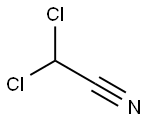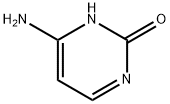Chemical Properties
colourless liquid
Uses
Dichloroacetonitrile can be used as a reactant to prepare:
- Chiral α, α-dichloro-β-aminonitriles via Pd-catalyzed enantioselective Mannich-type reaction with imines.
- α, α-dialkyl-substituted nitriles by an alkylation reaction with trialkylboranes in the presence of phenoxide base as a base.
- Halogenated pyridines via copper-catalyzed reaction with methacrolein.
- α,α-dichloro-β-hydroxy nitriles by condensation reaction with aldehydes and ketones in the presence of an alkoxide base.
- Selenium heterocycle derivatives via Diels–Alder cyclization with selenoaldehydes.
- Dichloroacetonitrile can also be used to develop an efficient method for the extraction and determination of common volatile halogenated disinfection by-products using the static headspace technique coupled with gas chromatography-mass spectrometry.
Definition
ChEBI: Dichloroacetonitrile is an aliphatic nitrile.
General Description
Clear liquid.
Air & Water Reactions
Burns slowly, emitting a thick black smoke, but will not flash . Water soluble.
Reactivity Profile
Dichloroacetonitrile is a halogenated nitrile. Nitriles may polymerize in the presence of metals and some metal compounds. They are incompatible with acids; mixing nitriles with strong oxidizing acids can lead to extremely violent reactions. Nitriles are generally incompatible with other oxidizing agents such as peroxides and epoxides. The combination of bases and nitriles can produce hydrogen cyanide. Nitriles are hydrolyzed in both aqueous acid and base to give carboxylic acids (or salts of carboxylic acids). These reactions generate heat. Peroxides convert nitriles to amides. Nitriles can react vigorously with reducing agents.
Health Hazard
ACUTE/CHRONIC HAZARDS: When heated to decomposition Dichloroacetonitrile emits toxic fumes of chlorine, cyanides and nitrogen oxides.
Fire Hazard
Dichloroacetonitrile is probably combustible.
Biochem/physiol Actions
Dichloroacetonitrile is direct-acting mutagen and induces DNA strand breaks in cultured human lymphoblastic cells. It induces apoptosis or necrosis in murine macrophage cell line via reactive oxygen intermediates-mediated oxidative mechanisms of cellular damage.
Purification Methods
Purify the nitrile by distillation or by gas chromatography. [Beilstein 2 IV 506.] FLAMMABLE.








